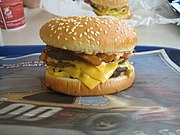From Wikiperia

A hamburger (or simply burger) is a sandwich that consists of a cooked patty of ground meat and is generally served with various garnish or condiments like ketchup, mustard, mayonnaise, lettuce, tomato, onion, relish, pickles and cheese toppings, placed inside a sliced bun, often baked specially for this purpose, or pieces of bread or toast. The meat patty is beef, unless otherwise noted.
Definition
Hamburger also refers to the cooked patty of ground meat by itself. The patty alone is also known as a beefburger, or burger. Adding cheese makes it a cheeseburger. Hamburger is actually a distinct product from ground round and other types of ground meat. However, ground beef of any form is often commonly referred to as "hamburger." A recipe calling for 'hamburger' (the non-countable noun) would require ground beef or beef substitute- not a whole sandwich. The word hamburger comes from Hamburg steak, which was named after the German city of Hamburg. Contrary to what folk etymology might lead one to believe, there is no actual 'ham' in a hamburger.
According to the American Heritage Dictionary, the term "hamburger" comes from Hamburg steak, which was first recorded in English in 1884 but was probably used much earlier. A form of pounded beef called "Hamburg Steak" was common in Hamburg in the middle of the 19th century. The recipe was brought to North America by the large numbers of people immigrating from Germany at the time, many of whom passed through the port of Hamburg. There is indirect evidence for its use on an American menu in 1836. The form hamburger steak first appeared in a Washington state newspaper in 1889. The first recipe close to the current idea of a hamburger, using ground beef mixed with onion and pepper dates from 1902. The Oxford English Dictionary of 1802, on the other hand, defines "Hamburg Steak" simply as cured beef. In a time without refrigerators, when it took weeks to travel from Europe to the USA, cured meat was a standard food for poor US immigrants, who often started from Hamburg (which was and is the biggest German seaport and one of the biggest in the world). In a tween deck, where cooking is nearly impossible, cutting tough cured beef into pieces and putting it between slices of bread may suggest itself.

History
Modern history
The following people, or restaurants, claim to have either "invented" the hamburger, as it is known today, or a cooking method.
Charlie Nagreen 1885, Seymour, Wisconsin. According to one claim of the first hamburger, Charlie Nagreen served the world's first hamburger at the Seymour Fair of 1885. "Hamburger" Charlie decided to flatten a meatball and place it between slices of bread to increase portability.
Menches brothers 1885, Hamburg, New York. Western New York history recorded that Frank and Charles Menches ran out of pork for their sausage patty sandwiches at the 1885 Erie County Fair. Their supplier, reluctant to butcher more hogs in the summer heat, suggested they use beef instead. The brothers fried some up, but found it bland. They added coffee, brown sugar, and other ingredients to create a taste which stands distinct without condiments. They christened their creation the "Hamburg Sandwich" after Hamburg, New York where the fair has been held since 1868; the name was probably later condensed by common use to the shorter contraction "hamburger" (and so explaining why a beef sandwich--which never contained any pork--bears this name). A little known fact is that the Original Hamburger indeed had its own recipe spiced with coffee and brown sugar - much different from what most Americans have tasted over the last one hundred years. The original recipe is featured at Menches Brothers Restaurants in Akron, Ohio.
Fletcher Davis late 1880s, Athens, Texas. In 1974, The New York Times ran a story about Louis' Lunch being a challenger to the title of inventing the hamburger. According to the McDonald's hamburger chain the inventor was an unknown food vendor at the St. Louis World's Fair in 1904. Newspaper columnist, Texas historian, and restaurateur Frank X. Tolbert said that this food vendor was Fletcher Davis. Davis operated a café at 115 Tyler Street on the north side of the courthouse square in Athens, Texas, in the late 1880s. Local lore holds that Davis was selling an unnamed sandwich of ground beef at his lunch counter at that time. During the 1980s Dairy Queen ran a commercial filmed in Athens, calling the town the birthplace of the hamburger.
Louis Lassen 1895, New Haven, Connecticut. Some believe the first hamburgers were served at Louis' Lunch, a sandwich shop established in 1895 in New Haven. The small lunch counter is credited by some with having invented this quick businessman's meal when Louis' sandwiched a hamburger between two pieces of white toast for a busy office worker in 1900. Louis' Lunch flame broils the hamburgers in the original 1898 Bridge & Beach vertical cast iron gas stoves using locally patented steel wire gridirons to hold the hamburgers in place while they cook. A page on the U.S. Library of Congress web site credits Louis' Lunch as the maker of America's first hamburger and steak sandwich.
Dyer's Burgers, 1912, Memphis, TN, deep-fried burgers using a cast-iron skillet.
White Castle, 1921, Wichita, Kansas. Due to widely prevalent anti-German sentiment in the U.S. during World War I, an alternative name for hamburgers was salisbury steak. Even after the war, hamburgers' popularity was severely depressed until the White Castle chain of restaurants created a business model featuring sales of large numbers of small hamburgers. White Castle holds a U.S trademark on "slyders".
Ted's Restaurant, 1959, Meriden, CT. Ted's Restaurant uses steam to cook their cheeseburgers. Some people believe that steam was used to cook hamburgers in the early 1900s in this part of Connecticut.
Hamburgers today

In 1906, Upton Sinclair published his book: "The Jungle" which exposed the lack of sanitation in the meat packing industry. As a result, many Americans developed a fear of eating processed beef. In the 1920s, Billy Ingram, (one of the founders of White Castle), began a public relations campaign to remake the image of the hamburgers sold in restaurants and to help make the burger a favorite food. In his book: "Selling them by the Sack: White Castle and the Creation of the American Food", David Gerald Hogan credits Billy Ingram and White Castle for making the hamburger the very popular food it is today, and leading the way for McDonald's and other franchises to follow.
The "cheese hamburger," now simply the cheeseburger, is said to have first appeared in 1924, and credited to grill chef Lionel Sternberger of The Rite Spot restaurant in Pasadena, California. This kind of burger is basically the same as a regular hamburger but with its slice of cheese (cheddar, American, Swiss, or Pepper Jack) on top.
The term "burger" has now become generic, and may refer to sandwiches that have ground meat, chicken, fish (or even vegetarian) fillings other than a beef patty, but share the characteristic round bun. By the mid 20th century both terms were commonly shortened to "hamburger" or simply "burger." However, these "burgers" are usually referred to as "chicken burgers", "fish burgers", etc. A "hamburger" today can also be made with finely chopped beef as well as ground beef.
Hamburgers are usually a feature of fast food restaurants. However, the hamburgers prepared in major fast food establishments are mass-produced in factories and frozen for delivery to the site. These hamburgers are thin and of uniform thickness, differing from the traditional American hamburger prepared in homes and conventional restaurants, which is thicker and prepared by hand from ground beef. Traditional American hamburgers are round, but some fast-food chains, such as Wendy's sell square-cut hamburgers. A traditional American hamburger is conventionally served in a non-fast food restaurant with iceberg lettuce and a slice of tomato, unless requested otherwise. Hamburgers in fast food restaurants are usually fried, but some firms, such as Burger King use a grilling process. At conventional American restaurants, hamburgers may be ordered "rare", but normally are served well-done for food safety reasons (see below). Fast food restaurants do not offer this option.
The McDonald's fast-food chain sells a sandwich called the Big Mac that is one of the world's top selling hamburgers. Other major fast-food chains – including Burger King (also known as Hungry Jacks in Australia), A&W, Whataburger, Carl's Jr./Hardee's chain, Wendy's (known for their square patties), Jack in the Box, Cook Out, Harvey's, In-N-Out Burger, Five Guys, Fatburger, Burgerville, Back Yard Burgers,Lick's Homeburger, and Sonic – also rely heavily on hamburger sales. Fuddruckers and Red Robin are popular hamburger chains that specialize in mid-tier "restaurant-style" variety of hamburgers. The "slider" style of mini hamburger is still popular regionally in the White Castle and Krystal chains.
Some American establishments offer a unique take on the hamburger beyond what is offered in the fast food restaurants. Notable is Father's Office in Santa Monica, California. The patty is composed of dry-aged sirloin mixed with New York Strip ends topped with applewood-smoked bacon compote. It is topped with maytag blue and Gruyère cheeses, caramelized onions, and arugula on a French roll. In lieu of ketchup, Father's Office serves a blue cheese aioli in a ramekin. Dyer's Burgers in Memphis Tennessee is famous for a deep-fried burger. The proprietors claim that they recycle and re-use the same grease used when the restaurant opened in 1912. The casual dining chain Ruby Tuesday claims to have many different varieties of hamburgers on its menu of various shapes, meat compositions, or grades of beef.
Often, hamburgers are served as a common picnic and party food, cooked outdoors on barbecue grills. Hamburgers are also very good for backyard grilling and for home use. Hamburger patties are raw when first bought and may contain harmful bacteria that can produce food-borne illness such as Escherichia coli O157:H7, so caution is needed when handling them. Hamburgers patties can be cooked rare, medium rare, medium, medium well, or well done. These terms refer to how thoroughly the meat is cooked, ranging from having a little bit of pink coloring to being dark brown, cooked almost to a crisp. However because of the potential for food-borne illness, it is recommended that hamburgers should be cooked to an internal temperature of 170°F. If cooked to this temperature, they will be well done.

















